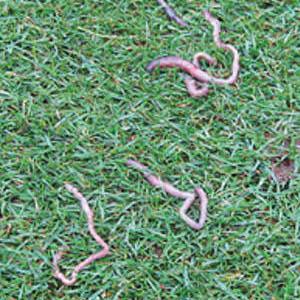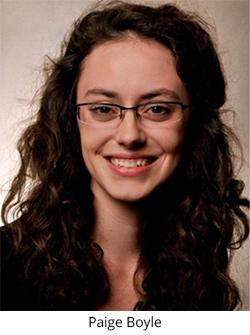Paige Boyle has one of the best Twitter handles ever. Her ID @BoyledWorms isn't just humorous and clever, it also provides a glimpse into her graduate research at the University of Arkansas.
 Boyle, under the direction of Mike Richardson, Ph.D., is in the second year of a study that she hoped would yield information for golf course superintendents looking to minimize worm castings on golf course. But so far, preliminary data have provided more of glimpse into what Boyle believes are differences in adaptability and behavior between earthworm species.
Boyle, under the direction of Mike Richardson, Ph.D., is in the second year of a study that she hoped would yield information for golf course superintendents looking to minimize worm castings on golf course. But so far, preliminary data have provided more of glimpse into what Boyle believes are differences in adaptability and behavior between earthworm species.Her hypothesis is simple.
"The goal of my research is to see if topdressing is a viable control option for earthworms, since they are a such a pest on golf course turfs and there are no pesticides labeled for use to control them," Boyle said.
"We were hoping to see if different rates of sand topdressing can help control earthworm activity, specifically surface casting. The idea behind it is the more sand you put out the more the earthworms would not want to be in that system because the sand is abrasive and they are soft-bodied organisms."
Boyle earned a bachelor's degree at Arkansas in environmental soil and water sciences. Her study on earthworms and topdressing combines her undergraduate work in soils with her graduate focus on turfgrass management.
 Her study that includes 16 Patriot Bermudagrass plots at the university's research farm, includes two topdressing treatments - one-quarter inch once annually and one-quarter inch four times per year. Both treatments are applied to sand-based and native soil rootzones. She also is collecting worm samples from four golf courses in Arkansas and Oklahoma.
Her study that includes 16 Patriot Bermudagrass plots at the university's research farm, includes two topdressing treatments - one-quarter inch once annually and one-quarter inch four times per year. Both treatments are applied to sand-based and native soil rootzones. She also is collecting worm samples from four golf courses in Arkansas and Oklahoma.She had hoped to prove that the increasing presence of topdressing sand would irritate the soft-bodied worms and send them in search of a more friendly, less sandy environment.
"When I go to the golf courses to collect samples, the superintendents are so frustrated by earthworms," she said.
"I thought topdressing would move them farther down into the soil or move them off onto the collar."
With less than a half-year left in her study, the preliminary results have not been what she expected.
"Actually we're seeing the opposite results so far," Boyle said. "With the heavy topdressing, we're experiencing more worm casting -- counter to what we are expecting initially.
"With the heavy topdressing, we're experiencing
more
worm casting -- counter to what we are expecting initially..."
"In the soil rootzone, there is less casting activity than in sand root zone regardless of topdressing treatment. It's been an interesting project, just not what we were expecting."
Although her final data might yield different findings, Boyle has a few theories on why her study is showing different results than what she expected.
There are more than 2,700 earthworm species known worldwide, according to the University of Illinois. Only a handful of those are found in the United States, and many of them are nonnative species brought here from other countries.
Those theories include varying population densities from one species to another depending on local soil conditions, varying levels of adaptability to sand abrasion between species or even a need for the earthworms to consume more organic matter to get full in a sandy environment, thus resulting in more castings.
She is collecting worm samples in hopes of studying their DNA to help round out her study and shed more light onto the behavior of worms. That includes boiling them and storing them in ethanol to preserve the integrity of their DNA. It also is what led to her Twitter handle.
"A lot of the ones that people are used to seeing, the big, dark red ones are actually European and Asian earthworm species," she said. "We think, but we don't know yet, is what we have are native earthworms and maybe they are more adapted to the temperatures we have here, or soil conditions. And maybe they are persisting in the system better than nonnatives. That's just a theory. We have to run the DNA."

